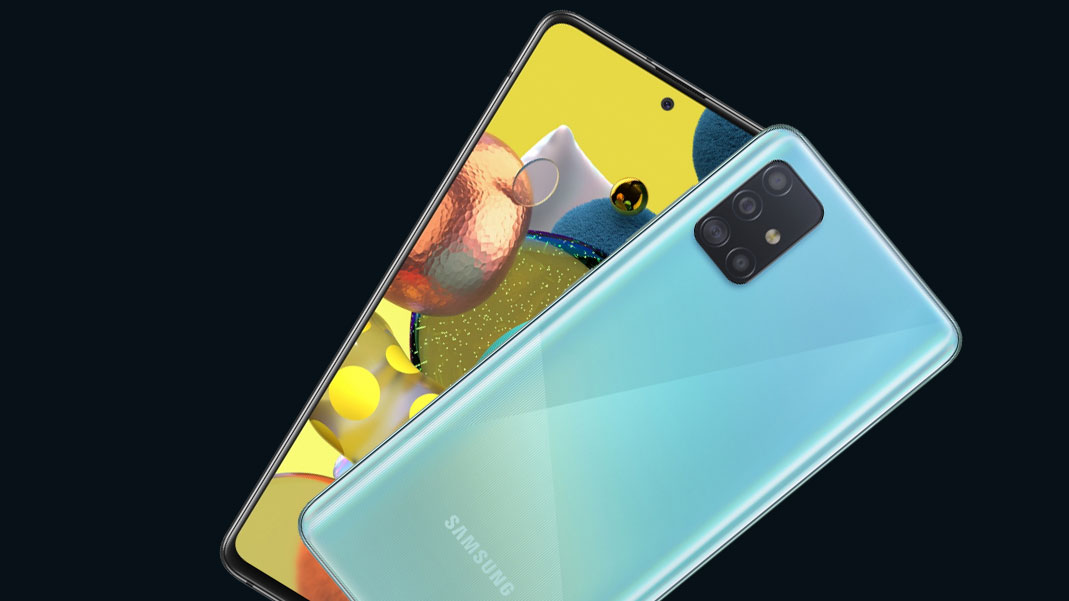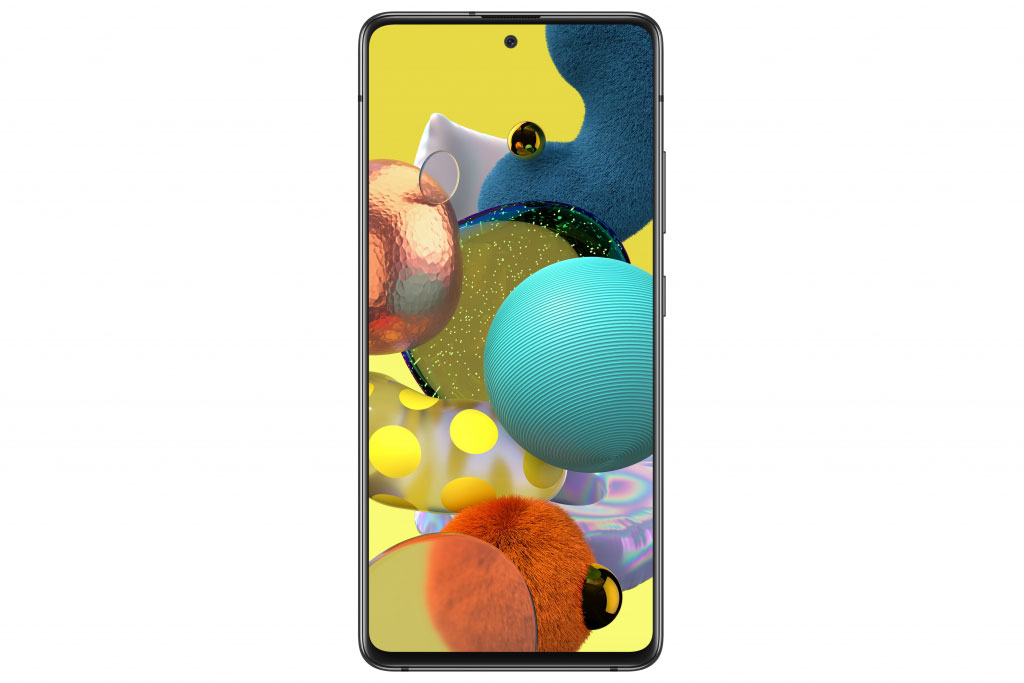Samsung Galaxy A51 review: Mid-range marvel
T3's official Samsung Galaxy A51 review is here


The Samsung Galaxy A51 packs a nice big display and a light, ergonomic design as sleek as its flagship siblings. A good budget phone for Samsung fans that want the look of the S20 and Note series.
-
+
Brilliant 6.5" Super AMOLED display
-
+
Amazing close-to-midrange camera
-
+
Good all-rounder for price range
-
-
Poor quality max zoom on camera
-
-
Plastic casing
Why you can trust T3


Dimensions: 158 x 79 x 7.9 mm
Weight: 172 g
Screen: 6.5-inch, FHD+, 60Hz, 1080 x 2400 pixels, 20:9 ratio
CPU: Exynos 9611
GPU: Mali-G72 MP3
RAM: 4GB
Storage: 64GB, 128GB
Rear cameras: 48MP, 12MP, 5MP, 5MP
Front cameras: 32MP
Battery: 4,000mAh
OS: Android 10.0, One UI 2.0
5G: No (A51 5G available)
Welcome to T3’s Samsung Galaxy A51 review. We’ve gone hands on with Samsung’s mid-range handset to bring you our official verdict on the phone. For ease of use, we’ve divided the review up into design, camera and specs, so you can breeze through and find the information you need.
To save you a little time, we’ll give you the gist of it: for £319, the Samsung Galaxy A51 is an excellent mid-range phone. It can’t complete with its premium cousins, of course, but it does work hard to evoke the same feeling as those top-tier flagships and eclipses rivals such as the Pixel 3a. A good buy for Samsung fans not willing or able to splash the cash on the S20 series or stretch as far as the S10e.

Samsung Galaxy A51 review: Design and screen
Samsung Galaxy A51 looks nice. That’s the first thing we notice. In fact, with its centred punch-hole on the front and rectangular camera module on the back, it looks remarkably like the Samsung Galaxy S20, with the exception of the headphone jack. Of course, being £500 cheaper, concessions have to be made: the phone’s body, for example, is made of plastic rather than the S20 series’ metal. It brings the weight down, which is nice in a larger handset, but it risks the phone feeling cheap in the hand with a relative lack of heft.
Fortunately, this is somewhat offset due to the phone’s sheer size. With a 6.5” screen comprised of Corning Gorilla Glass 3, the phone’s huge display, disturbed only by a small punch-hole (Samsung's smallest ever, in fact), looks premium quality.
The Full-HD screen is lovely and bright, with up to 650 nits and lustrous colours. It remains in the 60Hz ballpark as most mid-rangers do, but the screen still looks great when viewing content. Combined with the lack of bezel and the good build quality, the phone as a whole package looks like any other premium handset.
Samsung’s One UI 2, based on Android 10, is just a pleasure to navigate here as it is on the premium phones, especially with the A51’s big, bright screen leading the way. Android users are in familiar territory here: Samsung has crafted a slick, intuitive interface with a simple, easy-to-understand visual language.

Samsung Galaxy A51 review: Camera
Unusually for budget devices, the phone sports a penta-camera setup. The phone’s rear quad-camera array, based in a rectangular module, has 48MP wide-angle, 12MP ultra-wide, 5MP macro and 5MP depth lenses.
Get all the latest news, reviews, deals and buying guides on gorgeous tech, home and active products from the T3 experts
The 48MP wide-angle is easy to use and satisfying, capable of capturing high-quality scenic shots with sharpness and plenty of detail. The camera array supports up to 8x digital zoom, but you’ll never use this to its fullest extent on account of the noise, softness and general loss of any detail whatsoever at the maximum 8x zoom. Check out the photos below, in which you can see photos of the same church at 1x, 4x and 8x zoom:

1x Zoom

4x Zoom

8z Zoom
As we said, the further in you go, the less quality you get. Rather, you’ll likely live in the 2x to 4x range, which is where the camera really shines. It retains a good lock and picks out nice detail, as you can see here:

The bright colours do some with slight saturation, but still retain a lot of vibrancy
The colours are bright, if a little over-saturated upon rendering, and the details are nice and clear, with that 48MP lens really putting in work to ensure you've got plenty to work with in your shots. It will stand up wonderfully to being tinkered with in programmes like Photoshop.
We get a similar slight saturation with the 5MP macro lens, but it’s only a niggle. Otherwise, the macro is great, conveying depth and detail very well. It does take a little time to focus on the subject and we had a few false starts with the lens, but those willing to be patient will be rewarded with splendid close-ups.
The 32MP selfie camera is a welcome surprise. It’s unobtrusive on the screen (as we said before, it's Samsung's smallest punch-hole), easy to use and creates wonderfully detailed front-facing shots with little camera noise.
Backgrounds and over-the-shoulder details are crisp and clear without sacrificing focus on the subject, making the A51 perfect for those holiday selfies with Venetian bridges or the Arc du Triomphe in the background.

The phone records footage in 4K, and the level of detail captured is fantastic, but the cameras still suffer from shakiness and a small amount of motion blur. Nevertheless, the camera system is good for any phone at this price range, rewarding the user with high-quality, effortless snaps worthy of a phone at a much higher price.
Samsung Galaxy A51 review: Specs
The A51 is running the octa-core Exynos 9611, a chip with 10nm architecture as opposed to the smaller, superior 7nm architecture chips in the flagship S20 series. There's also 64GB or 128GB of internal storage and 4GB RAM, which is enough to power Android 10 and keep the phone’s background operations running smoothly. However, it's not quite a match for other Samsungs in the power stakes: the S10e, for example, packs either 6GB or 8GB RAM rather than the base 4GB offered here.
If 64GB memory is an issue, the phone has a microSD slot for cards of up to 512GB. You won’t be running out of space easily.The phone is packing a 4,000mAh battery and 15W fast charging. On moderate use, we got a good 36 hours at least, on average, out of a single charge, which only took a little over an hour to fill.
We’ve already spoken about the phone’s awesome Super AMOLED display, but unfortunately, the phone’s single speaker is a bit of a let-down, creating a tinniness that is especially jarring at higher volume. However, it makes up for this with the reintroduction of the headphone jack, which in our view has been sorely missed.
The 3.5mm jack technology has stood the test of time, and remain the port of choice for the very highest quality headphones. With a couple of good over-ear cans on, it's one of the best movie-watching mobile experiences you can get. USB-C headphones just don't quite do it justice.

Samsung Galaxy A51: Verdict
We’re sure at this point, you know the score. If you want a Samsung phone with peak performance, state-of-the-art chipsets and enormous 30-100x zoom cameras, you’ll want to spend an extra £500-£800 and nab yourself one of the Samsung Galaxy S20 series.
However, for a phone costing £319, the Samsung Galaxy A51 is a great handset. It’s not quite the best in its range (that honour goes to the iPhone SE 2020) but it sits nicely between the Google Pixel 3a and Samsung Galaxy S10e in terms of price, making it one of the best new Android phone for users with a limited budget. If you’re looking for a good Samsung handset that doesn’t cost the earth, you’ve come to the right place.

Matt Evans now works for T3.com sister brand TechRadar, covering all things relating to fitness and wellness. He came to T3.com as staff writer before moving on, and was previously on Men's Health, and slightly counterintuitively, a website devoted to the consumption of Scotch whiskey. In his free time, he could often be found with his nose in a book until he discovered the Kindle.